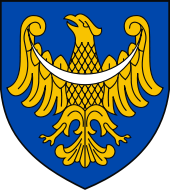Silesian Voivodeship (1920–1939)
The Silesian Voivodeship ( Polish : województwo śląskie ) was an administrative unit that included parts of Upper Silesia that had been ceded to Poland by Austria-Hungary in 1920 and by the German Empire in 1922 after the First World War . From 1922 to 1939 it was an autonomous voivodeship in the Second Polish Republic with the capital Katowice .
geography
The Silesian Voivodeship was the smallest voivodeship of the Second Republic of Poland in terms of area .
history
The founding statute of the Silesian Voivodeship of July 15, 1920 determined the basis of autonomy . At that time it consisted only of the part of the former Austrian Silesia that had come to Poland . When it was divided, the city of Teschen was split into a Polish and a Czech part . In its later borders, the voivodship did not exist until two years later, starting in June 1922, when Eastern Upper Silesia was ceded to Poland by virtue of the Versailles Treaty , taking into account the referendum in Upper Silesia , and became part of the voivodeship. In the period of Sanacja there were controversial plans of annexation of the Powiate Częstochowski with Częstochowa , zawierciański with Zawiercie and Będziński (see zagłębie dąbrowskie ) from the Province Kielce (1919-1939) and the western parts of the Powiate Chrzanowski with Jaworzno and Oświęcimski with Oswiecim , as well as the whole Powiate Bialski with Biała Krakowska and Żywiecki with Żywiec from the Krakow Voivodeship (1920–1939) . The plans were hotly debated in the press until World War II and shared public opinion (they were in fact largely implemented in 1998). On September 3, 1939, the voivodeship was abolished with the beginning of German occupation in World War II. The area of the voivodeship was connected to the administrative district of Katowice , which was also expanded with the new "East Upper Silesia" (the districts of Blachstädt, Warthenau, Ilkenau, Krenau, Bielitz and Saybusch). The voivodeship was formally dissolved on May 6, 1945 by the communist Krajowa Rada Narodowa (National Council of State), which also revoked its autonomy.
Voivodes of the Silesian Voivodeship
- 1922 : Józef Rymer
- 1922–1923: Zygmunt Żurawski
- 1923–1924: Antoni Schultis
- 1923-1924: Tadeusz Koncki
- 1924–1926: Mieczysław Bilski
- 1926–1939: Michał Grażyński
Demographics
The population density was 299 people per square kilometer, the highest of all provinces in Poland in the interwar period. In the 1931 census , 92.3% of the population gave Polish and 7% German as their mother tongue , according to which the Silesian Voivodeship had the highest percentage of Polish-speaking population of all voivodships in the Second Republic of Poland. The proportion of Poles was above average in rural areas with 95.6% of the population, while Germans with 12.9% of the urban population were almost twice as represented as in the voivodeship as a whole.
economy
The Silesian Voivodeship was one of the most developed and richest in the Second Republic of Poland. Their economy was based on mining and the metal industry. In 1923 73% of coal , 87.7% of zinc , 71% of steel and 99.7% of lead production in Poland came from there . The rail network density was the highest in Poland and was 18.5 km per 100 km². Foreign capital was heavily involved in the economy of the Autonomous Voivodeship, especially German, as many companies were already present in the area before the new border was drawn and were then active in both neighboring countries. Later, more French, Belgian and American capital was added, while the German companies withdrew due to the tense German-Polish relations, which reached their preliminary climax from 1925 in the customs war . The declared aim of German foreign policy at the time was to destabilize Poland economically and politically or even to force it into civil war and thus to revise its borders. The economic sanctions hit the Autonomous Voivodeship's economy particularly hard and almost caused it to collapse. Thanks to subsidies from Warsaw, the strike by the British miners and American investments in the steel industry, the situation was stabilized somewhat.
Administrative division
| Powiat | Area (km²) | Residents.³ | County seat | Residents |
|---|---|---|---|---|
| Powiat bielski¹ | 314 | 84,916 | Bielsko ¹ | ³ 22,332 |
| Powiat Cieszyński | 664 | 81,087 | Cieszyn | 15,324 |
| Powiat katowicki¹ | 170 | 341.203 | Katowice ¹ | ³ 126,058 |
| Powiat królewskohucki¹, ² | 6th | 101,977 | Królewska Huta ² | ³ 101,977 |
| Powiat lubliniecki | 706 | 45.232 | Lubliniec | 5,566 |
| Powiat pszczyński | 1072 | 162.015 | Pszczyna | 7,660 |
| Powiat rybnicki | 893 | 212,829 | Rybnik | 19,268 |
| Powiat świętochłowicki | 83 | 201.176 | Świętochłowice | 26,706 |
| Powiat tarnogórski | 250 | 64,592 | Tarnowskie Góry | 13,582 |
| ¹ Independent cities, including Bielsko and Kattowitz from 1930 | ||||
| ² 1934 renamed Chorzów or Powiat chorzowski | ||||
| ³ As of 1931 | ||||
literature
- F. Serafin (editor): Województwo Śląskie. University of Silesia , Katowice 1996.
Footnotes
- ↑ Ustawa z dnia October 18, 192, amendment to Art. 36 Ustawy Konstytucyjnej from July 15, 1920 ( Dziennik Urzędowy 1921, nr 85, poz. 608 ( Memento of the original from September 7, 2014 in the Internet Archive ) Info: The archive link was automatically inserted and not yet checked. Please check the original and archive link according to the instructions and then remove this notice. )
- ^ Dariusz Majchrzak: Śląska autonomia dla Zagłębia Dąbrowskiego? Sprawa włączenia Zagłębia Dąbrowskiego do województwa śląskiego w II RP (Polish)
- ↑ Drugi Powszechny Spis Ludności z dnia 9 grudnia 1931 ( 2nd census of December 9, 1931 ), publisher: Główny Urząd Statystyczny Rzeczypospolitej Polskiej
- ↑ Popiołek: dzieje Śląskie. Page 376.
- ↑ With the arms of the economy. by Wolfgang Zank


